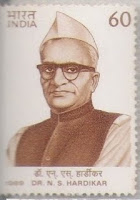Flags on Stamps; Facts File (Part-I)
World’s first stamps featuring Flag issued by
Costa Rica in the year 1863.
Denmark has the oldest flag ‘The Dannebrog’—as the Danish national flag is called – dropped traditionally ‘as a sign from heaven above’ on June 15, 1219, turning defeat into victory for the Danish crusaders under Valdemar the victorious in the ‘Battle of Lindanaes’ against the Pagan Esthonians.
1700 years of St. George’s Red Cross Flag
The legend goes that St. George rescued a princess from a dragon, dipped his lance in the dragon’s blood and traced a cross on his white shield. After the siege of Antioch in 1098, when the Crusaders were losing, Saint George with his flag and a host of heavenly soldiers appeared in the sky. The vision inspired the English to win the battle. Richard Coeur de Lion brought the story back to England, proclaimed St. George the nation’s saint and made his banner the national flag.
Saint George is the patron saint of Aragon, Catalonia, England, Ethiopia, Georgia, Greece, Lithuania, Palestine, Portugal, and Russia, as well as the cities of Amersfoort, Beirut, Bteghrine, Cáceres (Spain), Ferrara, Freiburg, Genoa, Ljubljana, Gozo, Milan, Pomorie, Qormi, Lod, Barcelona and Moscow, as well as a wide range of professions, organizations, and disease sufferers. (Wikipedia)
Red Cross flag is the first recognized International flag established in 1864 by the Geneva Conventions and Protocols.
Tonga’s flag prior 1875 was identical to Red Cross Flag, so they had to modify their flag with the proviso that the flag should never be altered again.
Avant-garde : Multi-colour Postage Stamp
Azerbaijan is the first country to produce multi-colour flag stamps in 1919. Then, considered a
technical break through on stamps.
First book on “Flags on Stamps” published in 1956.
Prior to that a compilation of ‘Flags on Stamps’ written by Ben Hamilton, Jr. was published in ‘Scott’s Monthly Journal’ for July, 1945. It listed over 6000 stamps featuring Flags.
First Omnibus Issue featuring Flag
[I] Flagship “San Gabriel” of Vasco-da-Gama in 1898 (ref. Discovery of Sea route to India, blog of April 30, 2010)
[II] “Flag of the (Hispanic) Race”, issued simultaneously from; Brazil, Guatemala, Honduras, and Paraguay in 1933.First 'Seamstress of Flag' on stamp; Cuba -1951
Emilia Teurbe Tolon sewing the first Cuban flag in 1850
******** *******

Some more interesting items on Swaraj flag (1921-1931) (from the collection of Sri G. Biswas of Kolkata)
 The Flag Committee -1931 headed by Dr. Pattabhi Sitaramyya after going through various suggestions as received from various sources came up with an entirely new design, all Saffron Flag charged with a brown Charkha at the top left corner (canton) of the flag.
The Flag design recommended by the Flag Committee failed to create any consensus amongst the Congress members in general and Muslims members in particular. The proposed flag was summarily rejected by the Congress Working Committee for the reason that the flag design interfered too much with the flag. As a result the all Saffron Flag never saw the light of day.
The Flag Committee -1931 headed by Dr. Pattabhi Sitaramyya after going through various suggestions as received from various sources came up with an entirely new design, all Saffron Flag charged with a brown Charkha at the top left corner (canton) of the flag.
The Flag design recommended by the Flag Committee failed to create any consensus amongst the Congress members in general and Muslims members in particular. The proposed flag was summarily rejected by the Congress Working Committee for the reason that the flag design interfered too much with the flag. As a result the all Saffron Flag never saw the light of day.The CWC which met at Bombay (now Mumbai) on August 5-6, 1931 presided over by Sardar Ballavbhai Patel approved a new “Tricolour” by substituting Saffron for Red and re-arranging the positions of the colours -- “Saffron over White over Green with a Charkha (Spinning wheel) in deep blue at the centre of the middle white stripe”. The new flag was named “Purna Swaraj Flag”.

The CWC was attended by amongst others, Mahatma Gandhi, Pandit Nehru, Dr. M. A. Ansari, Dr. Syed Mohammed, Sardul Singh Caveeshar, J. M. Sengupta, M. S. Aney, J. Daulatram, Abul Kalam Azad, Madan Mohan Malaviya, P. Sitaramyya, T.A.K. Sherwani, and Purushottamdas Tandon.
Dr. N. S. Hardikar was entrusted with the task to prepare the new flag. The original design had spindle of the Charkha (Spinning wheel) towards the flagpole, but later the position of the Charkha was changed.
(Note; P. Venkayya who is credited and correctly so, for the original Swaraj flag was in fact, not even consulted by the CWC while designing the new Purna Swaraj Flag in 1931. P. Rajeswar Rao in his book “Tha Great Indian patriot”. (Vol - I) tells us; ‘….. Venkyya had retired from active politics in 1922 as he had no faith in the non-violent Satyagraha of Mahatma Gandhi. He belonged to the old school of revolution….’. Many historians still erroneously mention ‘Venkayya’ as the designer of the Purna Swaraj flag).
(To be continued)























You have provided great information about Stamps and it is very important. It is quite beneficial for people to read such information.
ReplyDeleteThank you so much
Pincodezone
Flag of Ethiopia
ReplyDelete